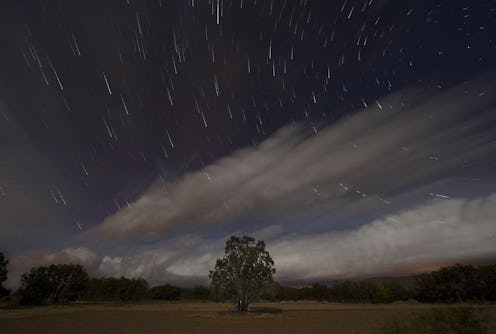News
When Is The Perseids Meteor Shower?
To many in the Northern Hemisphere, watching the annual Perseids meteor shower is a beloved summer tradition — and if you take NASA's word as truth, it's a stargazing ritual that dates back 2,000 years. If you're wondering when the Perseids meteor shower is this year, you'll be happy to know that the shower will be available for peak viewing on the evenings and early mornings between Tuesday and Friday this week. Specifically, the meteor shower can be "expected to reach its peak early Thursday at 4 a.m. ET," ABC News reported.
The meteor shower is created when Earth "passes through a cloud of the [Swift-Tuttle] comet's debris each year in August," leading comet dust to enter Earth's atmosphere at about 37 miles per second, according to NASA. The bright lights that streak across the sky are caused by the comet dust disintegrating. You can expect to see as many as 100 shooting stars in the sky per hour, from northerly or southerly latitudes depending on whether you live in the Northern or Southern Hemisphere. Thankfully, as the moon is in its waning crescent phase, the lack of moonlight will make for a darker sky that will make passing meteors easier to spot.
According to experts at Earth Sky, although the meteor shower will peak at twilight, you shouldn't rule out previewing the shower in early evenings this week. Why? Sure, less meteors streak the sky at this time, but early evening is the only time of day you'll have any chance of catching an "earthgrazer," or a "[long], slow and colorful" meteor that shoots horizontally across the sky. They're exceedingly rare, but if you're lucky enough to see one, you'll only see it early in the evening. If you doubt your odds of catching one, you're most likely to see the most Perseid meteors grazing the sky late into the night or very early in the morning, shortly before sunrise.
For the best view possible, you'll want to find a space that looks up directly into a dark open sky that's far from artificial light. If you live in an urban area, you could achieve this by planning a last-minute camping trip or going on an evening hike with friends. According to NASA, looking toward the Cassiopeia and Perseus constellations in the northeastern part of the sky, you'll find the best view of the shower. However, to get a standard view of the Perseids meteor shower, you don't really have to plan any nature getaway or have any knowledge of constellations. You could enjoy the shower plenty by simply going to any part of your backyard that gives you a clear open look at the night sky.
